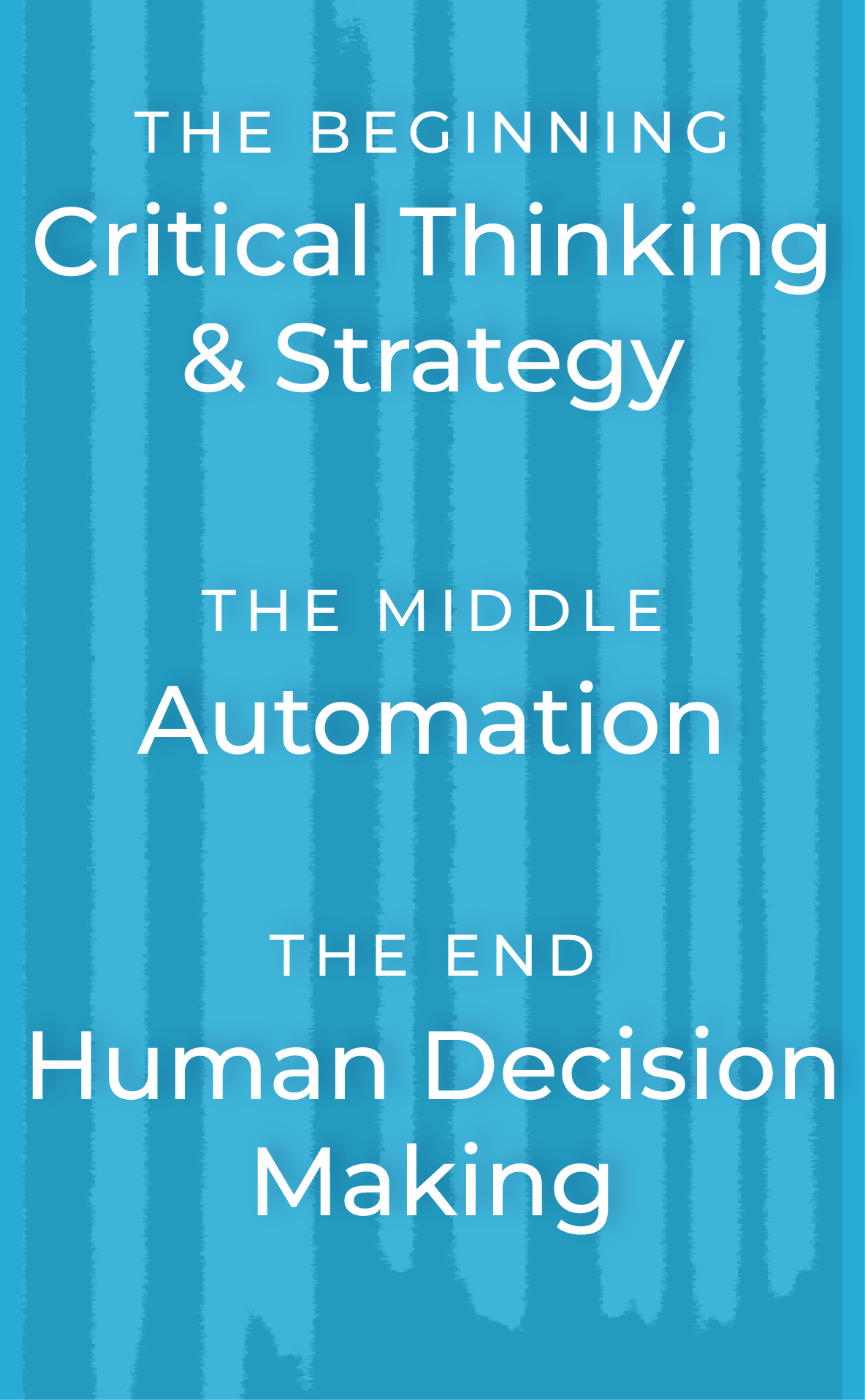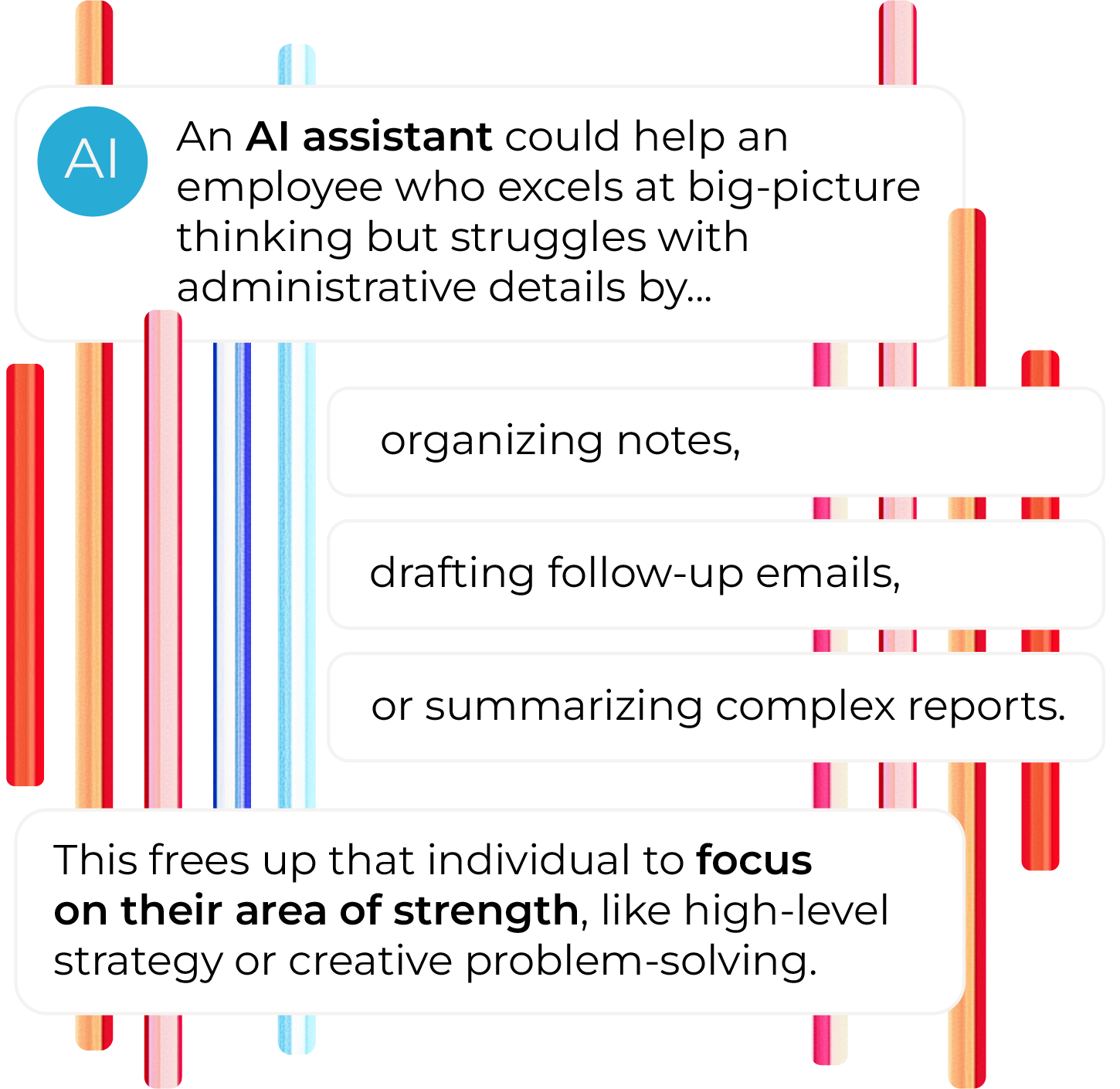The rise of artificial intelligence is reshaping how we work, hire, and lead. From automating workflows to changing the very skills we value, AI presents both a massive opportunity and an ongoing challenge.
Here are answers to some of the most pressing questions executives ask me about AI’s impact in the workplace.

Q: How can leaders justify the ROI of AI investments without replacing roles?
A: This is a major conversation in boardrooms right now. It’s difficult to model the ROI perfectly, and it requires a phased approach: evaluation, rollout, and intensive training.
I talked about how businesses can begin implementing AI in my last post. Basically, we’re seeing two main camps: companies jumping in full-force to ride the wave, even with imperfect software, and more cautious companies that are waiting for fully baked solutions.
The key is to shift the conversation away from simple cost-cutting and instead, focus on value generation. The right question to ask is: “How can this investment allow our current team to deliver higher-value, more strategic, and more efficient work?”
True ROI comes from increasing your team’s impact and output, not just from trimming the budget.
Q: If AI handles foundational tasks, how will early-career professionals build the experience and judgment they need to grow?
A: This challenge requires a shift in both hiring profiles and training methods, because the role of a junior employee has permanently changed.
First, recruiting teams must be much more specific about the attributes they’re hiring for. In today’s AI-forward world, there’s a distinction between skills and abilities. Skills are what a candidate already knows how to do, and abilities are what they are capable of learning and doing. These innate, durable abilities are becoming far more important.
For example, the ability to influence, analyze data, communicate effectively, learn fast, adapt, and think critically in the face of evolving tools are what help candidates stand out. The old profile of a junior employee who is great at foundational research but lacks these soft abilities is no longer valid, simply because AI tools can now help with much of that research. Ultimately, this focus on durable abilities over current skills is true for professionals at any career stage.
Second, early-career professionals will likely be managing the AI “bots” and tools rather than doing all the manual work themselves. To build their industry experience and “gut instinct,” we have to find new ways to train them.In executive search, for example, this looks like an apprenticeship model. Instead of having junior employees learn by making 100 cold calls, at True, we’ll have them sit in on senior-level interviews and strategy calls to learn from observation. A significant part of their training also focuses on how to use the new tools effectively: mastering the art of writing effective prompts, being critical of the output, and then editing and further prompting to refine the results.

Q: What human skills and job elements are least likely to be automated by AI?
A: While some highly predictable workflows with binary, true / false outcomes may eventually be fully automated, more human-centric workflows are not so simple. For any process that requires nuance, subjective judgment, or strategic thought, the best way to think about AI’s role is by looking at that workflow in three parts.

The beginning: The start of the workflow is inherently human. This involves critical thinking and strategy. We have to figure out what problem we’re trying to solve and what instructions (the prompt) to give the AI.
The middle: This part is the best place to automate, where the “doing” or the “processing” happens.
The end: The final human decision-making at the end of the workflow is also unlikely to be automated. This is where you apply decades of experience, context, and “gut instinct” to the output, something a bot simply can’t replicate.
Q: What specific skills will be most important for professionals in the age of AI?
A: The key skills we see becoming non-negotiable are:
- Adaptability: The ability to be nimble and navigate constant change.
- AI fluency: Being “AI-native,” or being comfortable and effective at using and prompting AI tools, and “high agency,” a proactive drive to experiment and figure things out. This also means applying critical judgment to how the tools are used, the quality of their output, and any necessary refinement.
- High emotional intelligence (EQ): The human-centric skills of empathy, self-awareness, and relationship management that AI lacks.
- Communication and influence: The ability to translate data-driven insights into a compelling narrative and influence stakeholders.
Q: How is AI changing the collaboration between the CHRO and the CIO / CTO?
A: This partnership is becoming more intertwined, and its success directly impacts the future of the organization. The joint goal is to make sure that technology investments serve both operational and human outcomes.
The CIO / CTO evaluates the technology, data infrastructure, and security risks. They focus on how AI will be embedded in the company’s products along with the processes used to create them.
The CHRO oversees the human aspect of the transformation, driving company-wide AI adoption and trust while managing organizational change. This includes identifying and developing AI-savvy talent, and collaborating with stakeholders and subject matter experts across teams.
A key shared priority is upskilling and reskilling: the CIO / CTO identifies emerging tech needs, and the CHRO executes the workforce planning and L&D programs to fill those gaps.

They must work together to rethink and redesign core processes, rather than just layering new tech onto old, broken workflows. Ultimately, the CIO / CTO sources the tool, but the CHRO ensures the people can use it to create value.
Q: What are the biggest missteps companies can make when adopting AI?
A: We see a few common pitfalls:
Lack of a foundational data layer:
With equal access for anyone, AI models are not a differentiator, and “prompting as a competitive advantage” will diminish. A solid, organized foundational data layer is the backbone for long-term success.
Ignoring risk:
Failing to properly address the critical compliance, data privacy, and security concerns from day one.
Trusting the output blindly:
Allowing teams to use results from AI tools without having the internal expertise to “gut-check” those results and understand their nuances.
Layering instead of rebuilding:
AI is an amplifier, and it will only exacerbate problems created by broken processes. This is a good time to rethink the entire workflow instead of simply layering new tools onto inefficient systems.
Lack of vision:
Adopting tools at random without a clear, strategic vision from leadership about why they’re doing it.
Q: If AI makes our workforce more efficient, how do we measure the value of the time we get back?
A: This is the right question to ask. The goal isn’t just “time saved,” it’s “time reinvested.” You don’t measure the value in hours not worked, you measure it in the new output those hours create.
For example, is your marketing team spending less time writing first drafts and more time on high-level strategy and experimentation? At True, we look at whether our recruiters spend less time sourcing and more time building deep relationships with high-potential candidates. That’s where the value is. The metric shifts from efficiency (e.g. number of candidates sourced) to impact (e.g. quality of hire, strategic impact on the business, and ability to deliver higher-value work).

Q: How can companies attract top AI talent if they can’t compete with top-tier budgets?
A: You have to lead with something other than money. For many companies, this means focusing on attracting mission and vision-driven talent. Top-tier AI professionals want to solve interesting, complex problems. You can compete by offering:
Impact: A clear line of sight to how their work will directly impact the business or its customers.
Interesting problems: Frame your company’s challenges as unique, data-rich problems that AI can solve in a novel way.
Autonomy: The freedom to experiment, build, and own projects.
Flexibility: Offer a better work-life balance or a more supportive, less bureaucratic culture than a large corporation.
Q: How should we approach training leaders who will need to manage hybrid teams of both humans and AI agents?
A: This is a new frontier for leadership development. Managing a human-AI hybrid team requires a new playbook:
- Leaders must become AI-native themselves, and understand the tools’ capabilities and their limitations and nuances.
- Their focus must shift from managing tasks to managing workflows, becoming responsible for orchestrating how the human team members and the AI agents collaborate, and ensuring the AI’s output is properly gut-checked and integrated.
- The human side of leadership becomes even more important: Leaders will need to be exceptional coaches, focusing on the very things the AI can’t do, like developing their team’s critical thinking, emotional intelligence, and influence skills.
Q: How might AI create a more level playing field by addressing different cognitive abilities in the workplace?
A: Technology can be an equalizer for a neurodiverse workforce when applied thoughtfully. By removing friction from foundational tasks with the help of AI, employers can design a more personalized and supportive work environment that augments each individual’s abilities.
For example, an AI assistant could help an employee who excels at big-picture thinking but struggles with administrative details by organizing notes, drafting follow-up emails, or summarizing complex reports. This frees up that individual to focus on their area of strength, like high-level strategy or creative problem-solving.

In recruiting, AI-powered assessment tools can help move past traditional interview or resume-screening biases. They can be built to identify core competencies, problem-solving skills, and future potential, regardless of how a candidate processes or communicates information, much like how we’ve designed True View.
AI can also adapt to different learning and communication styles. Instead of a one-size-fits-all training manual, AI could present information visually, audibly, or in a more interactive way, depending on the user’s needs. For example, companies like Neuralink are exploring even more profound applications for individuals with severe disabilities. These initiatives are still in the very early stages of human trials, but they show considerable promise.
Q: How is AI changing the profile of the “modern recruiter”?
A: As AI automates foundational sourcing and administrative tasks, the recruiter’s value shifts entirely to high-impact, human-centric work.
They are responsible for aligning key stakeholders from the board and investors, to the hiring team, around critical candidate archetypes, DEI, and organizational goals.

They manage the entire process with truth and sensitivity, advising on everything from strategic career alignment and optimal reporting lines to complex compensation negotiations for both clients and candidates.
Their time is reinvested in high-touch activities: conducting deep interviews, performing nuanced back-channel and referencing work, sourcing talent for future ideas and introductions, and ensuring they professionally close the loop with all parties.
The modern recruiter is an expert at managing the AI tools, analyzing the data, and using their high EQ and influence to navigate the complex human dynamics of an executive search.
INSIGHTS FROM

Josh Withers
Founder and GM, Platform & North America
Search Operations, Head of Thrive
For media inquiries, contact Jillian Ruggieri